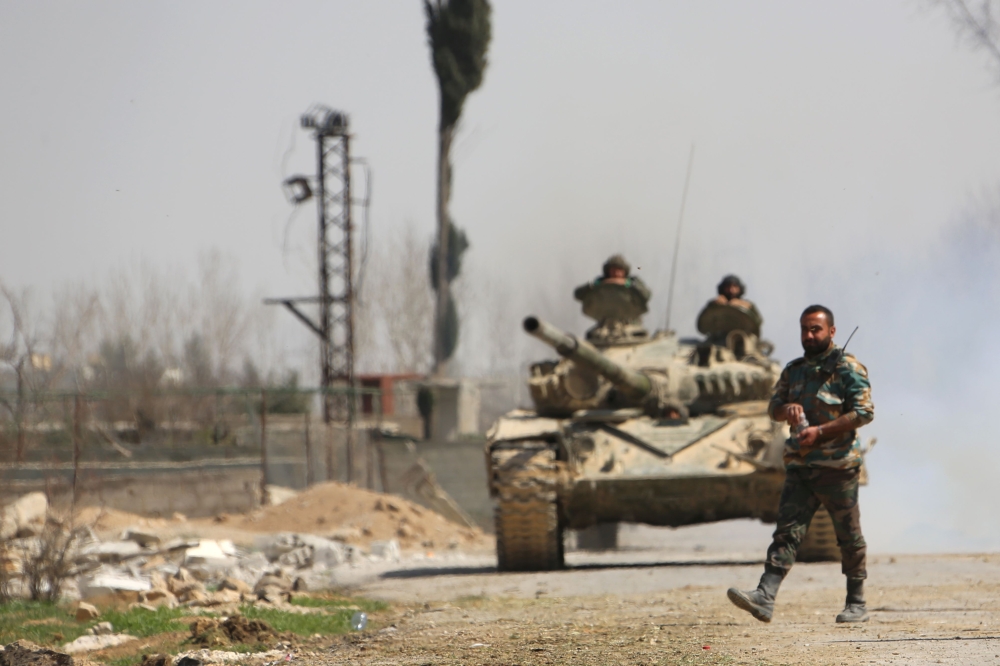
Beirut — Syria's besieged Eastern Ghouta region, the last opposition-controlled pocket near Damascus, has for nearly three weeks been pounded by regime forces in an assault that has killed over 1,000 civilians.
Here is a summary of events in the rebel enclave, home to around 400,000 people, since the start of the Syrian conflict.
Battles, bombings, escalation
In July 2012, a little over a year after peaceful anti-government protests launched into a full-scale uprising, Free Syrian Army (FSA) rebels attack the capital from Ghouta.
Regime forces quickly reassert control, but some areas fall to rebel groups, who set up base in Eastern Ghouta.
The region becomes the target of regular bombings and artillery strikes: markets, schools and hospitals are hit.
By 2013, Eastern Ghouta is under a strangulating regime siege, slashing access to food, medicine, and other goods for several years as government slowly chips away at rebel territory.
Under a May 2017 deal between rebel backer Turkey and regime allies Russia and Iran, Ghouta is declared one of four "de-escalation" zones.
But the government maintains its blockade and renews bombardment in mid-November, pulverizing buildings and streets.
In early February 2018, a wave of intense bombardment leaves around 250 civilians dead and hundreds wounded in five days.
The regime launches an even more ferocious assault on the enclave on February 18, killing more than 1,000 civilians and overrunning more than half the territory in nearly three weeks.
According to an AFP correspondent in the enclave's main town Douma, the landscape is devastated.
UN chief Antonio Guterres says Eastern Ghouta has become "hell on Earth", while the UN's human rights chief Zeid Ra'ad Al Hussein says Damascus is orchestrating an "apocalypse".
Chemical attacks
The Syrian regime is also accused of carrying out chemical attacks on Eastern Ghouta and elsewhere.
On Aug. 21, 2013 hundreds of people, including many children, are killed in a chemical attack on the region and another rebel bastion near Damascus, Moadamiyet Al-Sham.
Washington accuses the Syrian government of responsibility, saying more than 1,400 people, including 426 children, died.
The US and regime ally Russia reach last-gasp agreement demanding the destruction of Syria's chemical weapons arsenal, thereby avoiding American and French air strikes on government positions.
A UN report concludes days later that the evidence from the August 21 attack "unequivocally and objectively" proves sarin gas was used.
In January 2018, several people die in suspected regime chlorine gas attacks near Damascus.
On February 5, US ambassador Nikki Haley tells the UN Security Council that there is "obvious evidence from dozens of victims" to prove the chlorine attacks.
Following a French warning of punitive strikes, the Syrian government again denies it possesses chemical weapons.
Malnutrition, siege
Eastern Ghouta was once the breadbasket of Damascus, providing rich harvests of apricots and vegetables to the capital.
But siege and bombing have sparked crippling shortages of food and medication. Some food is still grown locally or smuggled in, but prices are soaring.
Following the publication of shocking images of severely malnourished children in October 2017, the UN condemns "the deliberate starvation of civilians as a method of warfare".
The following month, the UN children's agency UNICEF says childhood malnutrition levels in the region are the highest recorded in Syria.
"Eastern Ghouta is experiencing a Middle Ages-style siege," France's UN ambassador Francois Delattre tells reporters in early January.
The first UN aid convoy in months is able to enter the region on March 5, after the UN ordered a humanitarian truce, but offloading is cut short after fresh air strikes nearby.
A second convoy enters on March 9 to deliver desperately-needed food assistance to thousands, but the regime maintains its crippling siege and brutal offensive. — AFP